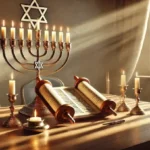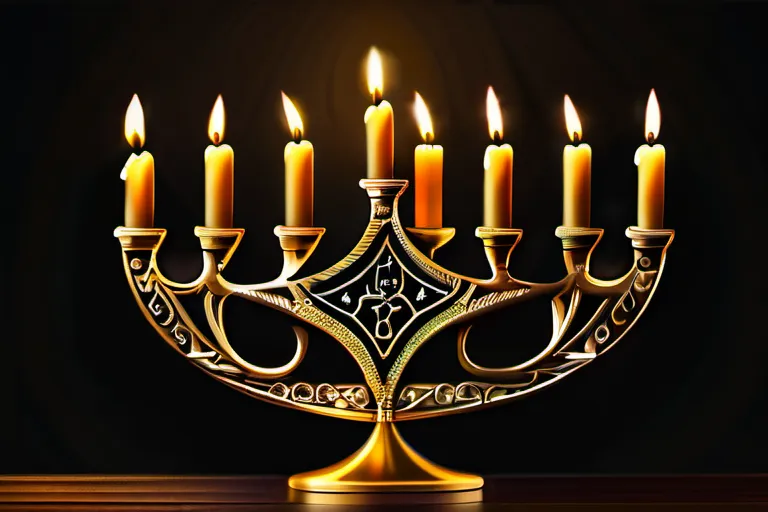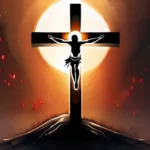Exploring the History, Meaning, and Cultural Importance of the Menorah in Jewish Tradition
The menorah is a six-branched candelabrum that holds great significance in Judaism. Originally used in the Tabernacle and later in the Temple, it symbolizes unity, divine presence, and spiritual enlightenment.
The Historical Significance of the Menorah
The historical significance of the menorah in Judaism is like a thread weaving through the rich tapestry of Jewish tradition and history. Imagine, for a moment, stepping back to the time when Moses led the Israelites out of Egypt. The menorah was not just any lamp; it was the source of divine light, burning brightly as a beacon of freedom. How did this humble yet profound symbol come to hold such a central role in Jewish life?
The origins of the menorah date back to the wanderings in the wilderness. According to the Bible, God commanded Moses to build the menorah for use in the Tabernacle, described as a golden candelabrum with seven branches. Each branch represented one of the days of creation, and together they symbolized the world under God’s watchful eye. In the grander context of the First and Second Temples, the menorah stood as a constant reminder of divine presence amidst the chaos of earthly life.
But the menorah didn’t just sit in the background; it played an active role during various periods in Jewish history. In the time of the Maccabees, after their victory over the Seleucid Greeks and the rededication of the Temple (the event commemorated by Hanukkah), the menorah symbolized resilience and hope. It reminded Jews that even in the darkest times, light could still shine through.
Fast forward to more recent history, where the menorah continues its role as a powerful symbol. In modern synagogues, it stands as a focal point during prayers and celebrations. Its seven branches represent the unity of the Jewish people, with every branch holding a candle that signifies different aspects of their shared heritage.
The menorah, then, is more than just an ornate lamp; it’s a living testament to Jewish continuity and faith. It serves as a reminder that amidst life’s trials, there is always hope for brighter days. As we gaze upon the menorah today, let us reflect on its enduring significance and the lessons of resilience it imparts.
Symbolism and Meaning of the Menorah
The menorah, with its seven branches, stands as more than just a lamp; it’s a symbol steeped in profound meaning and rich symbolism. Imagine, if you will, a tree with seven branches reaching out to the world—each one representing a different aspect of Jewish tradition and spiritual practice. How does each branch convey its unique message?
The central branch, or shamash, serves as the helper, providing light for the other six branches. It is like the heart that keeps the whole tree alive, emphasizing the importance of service and selflessness in Jewish life. Could this not be likened to the role of a community leader who ensures everyone’s needs are met?
The shamash also symbolizes leadership and guidance, much like a lighthouse shining through the fog. It reminds us that even in times of darkness, there is always someone willing to light our way. How often do we overlook this central branch, assuming it’s just for practical purposes? Yet, its significance lies in how it connects each of the other branches to the divine.
Each of the other six branches has its own unique symbolism. Two might represent the first and second commandments, while another could symbolize the values of charity and justice. The remaining three might stand for wisdom, faith, and hope—embracing the core values that guide Jewish life. How can we think about these branches as a family tree, with each one holding up its part to support the whole?
Moreover, the oil lamp itself holds great significance. It is a symbol of divine presence, reminding us that God’s light illuminates our path and sustains us through darkness. The flame represents spiritual enlightenment and the constant struggle for knowledge and understanding. How often do we extinguish this inner light within ourselves? Could it be that keeping the menorah lit is not just about following tradition but also about nourishing our souls?
The menorah, then, becomes a powerful metaphor for unity, divine presence, and spiritual growth. It serves as a reminder of the interconnectedness of our community and the importance of maintaining a connection to our faith. As we light each candle during Hanukkah or Shabbat, we are not just honoring a historical event but also reinforcing these core values that have sustained Jewish life for millennia.
The Menorah in Jewish Tradition
The menorah isn’t just a symbol; it’s a living, breathing reminder of light triumphing over darkness. During Hanukkah, when we light the candles of the hanukkiah (a special nine-branched menorah), we do more than celebrate a miracle. We reenact the story of the Maccabees and their struggle for religious freedom. The eight lights represent the days of oil that miraculously burned in the rededicated Temple, while the ninth candle, known as the shamash (helper light), symbolizes our responsibility to be that guiding light for others.
On Shabbat, as families gather around the synagogue’s central menorah or in their homes with a smaller table of candles, they honor a sanctified day. The lighting ceremony becomes a moment of communal reflection and connection, where the physical act of kindling lights serves as a bridge between past and present, binding Jews across generations.
In synagogues, the menorah’s presence is profound. It stands tall like a beacon in the sanctuary, drawing eyes to its elegant form that often features intricate designs representing eternal life or divine glory. This fixture isn’t merely decorative; it serves as a physical manifestation of God’s presence, reminding worshippers that even within the most humble settings, there is a profound spiritual connection waiting to be discovered.
The menorah’s role during Yom Kippur, the Day of Atonement, adds another layer of significance. In some traditions, it’s covered with a cloth or hidden away, symbolizing how on this day, light and darkness coexist in our quest for spiritual cleansing. The act of uncovering it later signifies new beginnings and the potential for renewal that Yom Kippur offers.
As we delve into the menorah’s deeper meanings, it becomes clear why this simple yet intricate vessel holds such a revered place in Jewish tradition. It’s more than just a decorative piece; it’s a witness to history, a symbol of hope, and a conduit for spiritual reflection. Each flame it bears lights up not only the room but also the hearts and minds of those who gaze upon its beauty.
The Menorah in Art and Literature
The menorah’s presence in Jewish art and literature serves as a powerful symbol, often weaving through the tapestry of history like threads of golden light. How many times have you gazed upon a depiction of the menorah in ancient mosaics or paintings, wondering about the stories they tell? These artistic representations aren’t just illustrations; they are windows into the soul of Jewish culture and heritage.
Imagine stepping into a synagogue where the walls are adorned with intricate menorah designs. Each line, each curve tells a story of resilience and faith. The menorah in art becomes more than just an object—it embodies the enduring spirit of the Jewish people. How does one capture the essence of this symbol through mere brushstrokes or chisel marks? Every artist faces this challenge, striving to bring out the profound meaning behind the seven-branched candelabrum.
In literature, too, the menorah holds a special place. Think about the tales and poems that mention it—how often does the menorah appear as a central figure or a subtle metaphor? It’s almost as if the menorah itself whispers through the verses, reminding us of the light of wisdom and the enduring flames of hope. How can words convey the same sense of sanctity and significance as those golden lights?
The menorah in art and literature is not just about depicting an artifact; it’s a journey into the heart of Judaism’s traditions and values. It serves as a reminder of the past, while also guiding us towards a better future. How can we appreciate these artistic renditions without understanding their deeper meanings? Each piece tells a story of Jewish identity, survival, and spiritual devotion.
From illuminated manuscripts to modern digital art, the menorah continues to inspire creators across generations. Its presence in various forms enriches our understanding of Jewish culture and history. As we explore these artistic interpretations, we find ourselves asking: what does it mean to carry this symbol into our own lives? How do these visual and literary depictions shape our connection to Judaism?
The menorah’s journey through art and literature is a testament to its enduring significance in the Jewish tradition. It stands as a beacon of hope, guiding us through the darkest times and reminding us of the light that sustains us.
Modern Interpretations of the Menorah
The menorah has become more than just an ancient symbol; it’s a beacon of Jewish identity and continuity in our modern world. How does this historic candle holder transcend time to resonate with contemporary Jews? The menorah, with its seven branches, serves as a powerful metaphor for the light of wisdom, enlightenment, and hope that Judaism brings into the world.
Think about it: when we light the menorah during Hanukkah, aren’t we invoking something deeper than mere celebration? Could it be our quest to illuminate the darkness within ourselves and society through acts of kindness, learning, and community building?
- Is the menorah a symbol that connects us not just to our past but also to our present struggles and triumphs?
- How does it inspire us to be torchbearers of tradition in an ever-changing world?
In many synagogues today, you’ll see the menorah used as a focal point during services. Its presence evokes a sense of belonging and reverence among worshippers. But beyond its traditional role, how has the menorah evolved to address contemporary challenges faced by Jews worldwide?
The menorah often appears on Jewish logos and emblems, serving as a unifying symbol that transcends denominational differences. It represents shared heritage and values in an increasingly diverse community. Is it this universal appeal that makes the menorah so potent in today’s society?
Moreover, the menorah has found new expressions through modern art and design. Artists and craftsmen have reimagined the symbol to reflect contemporary themes and aesthetics, from digital menorahs to eco-friendly candle holders made from recycled materials.
In this dynamic landscape, the menorah remains a living testament to Jewish resilience and innovation. Could it be that its enduring presence is not just about maintaining tradition but also about adapting and thriving in new contexts?
The Menorah’s Legacy and Future
The Menorah’s Legacy and Future: Explore the menorah’s enduring significance in Jewish culture, its role as a unifying symbol, and its potential impact on future generations.
Imagine the menorah not just as a lamp but as a beacon of light piercing through the darkest nights. For millennia, it has served more than merely a utilitarian purpose—it is a profound symbol that guides us through the labyrinth of Jewish history and identity. How does this ancient artifact continue to inspire and shape our present? The menorah stands as a testament to resilience and continuity, much like an evergreen tree standing tall in winter’s frost.
Consider how the menorah unites Jews across the globe during Hanukkah celebrations. It’s not just a tradition but a communal ritual that strengthens bonds among families and communities. Can you imagine the menorah as a thread weaving together diverse Jewish experiences, from Ashkenazi to Sephardic traditions? Each candle lit is like a promise of shared heritage and collective memory.
As we look to the future, what role will the menorah play in shaping Jewish identity for younger generations? Will it remain a relic of history or transform into something new and dynamic? The menorah’s legacy invites us to think beyond its physical form—what stories does it tell about our past and how can it guide us towards our future?
Through art, literature, and technology, the menorah continues to evolve. How might we reimagine this symbol in modern contexts, such as digital media or interactive installations? These new interpretations could breathe fresh life into an age-old tradition, making it more relevant and accessible than ever before.
In summary, the menorah’s enduring significance lies not just in its past but also in its potential to shape our collective future. As we light these candles, let us remember: every flame represents a piece of history, culture, and hope. What will be your contribution to this eternal legacy?
Conclusion
 Understanding the menorah’s history, symbolism, and role in Jewish tradition deepens our appreciation for this iconic artifact. By embracing its teachings, we can cultivate a stronger connection to Judaism and its rich heritage.
Understanding the menorah’s history, symbolism, and role in Jewish tradition deepens our appreciation for this iconic artifact. By embracing its teachings, we can cultivate a stronger connection to Judaism and its rich heritage.











